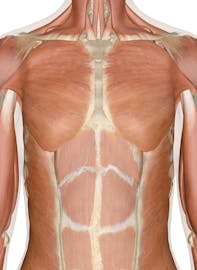The Muscles of the Chest and Upper Back
Explore the anatomy and function of the chest and upper back muscles with Innerbody's interactive 3D model.

The muscles of the chest and upper back occupy the thoracic region of the body inferior to the neck and superior to the abdominal region and include the muscles of the shoulders. These important muscles control many motions that involve moving the arms and head --- such as throwing a ball, looking up at the sky, and raising your hand. Breathing, a vital body function, is also controlled by the muscles connected to the ribs of the chest and upper back.
The bones of the pectoral girdles, consisting of the clavicle (collar bone) and scapula (shoulder blade), greatly increase the range of motion possible in the shoulder region beyond what would be possible with the shoulder joint alone. The muscles of this region both allow for this range of motion and contract to stabilize this region and prevent any extraneous motion. On the anterior side of the thoracic region, the pectoralis minor and serratus anterior muscles originate on the anterior ribs and insert on the scapula. These muscles work together to move the scapula anteriorly and laterally during pushing, throwing, or punching motions. In the upper back region, the trapezius, rhomboid major, and levator scapulae muscles anchor the scapula and clavicle to the spines of several vertebrae and the occipital bone of the skull. When these muscles contract, they elevate the pectoral girdle (as in shrugging) and move the scapula medially and posteriorly toward the center of the back (as in rowing). The trapezius also contracts along the back of the neck to extend the head at the neck and hold it upright throughout the day.
Nine muscles of the chest and upper back are used to move the humerus (upper arm bone). The coracobrachialis and pectoralis major muscles connect the humerus anteriorly to the scapula and ribs, flexing and adducting the arm toward the front of the body when you reach forward to grab an object. On the posterior side of the arm the teres major and latissimus dorsi extend and adduct the arm towards the scapula and vertebra when you pull an object down off of a shelf above your head. The deltoid and supraspinatus muscles run superiorly between the scapula and humerus to abduct as well as flex and extend the arm. These muscles allow us to raise our arm in the air or swing the arm as in throwing a ball underhand. Rotation of the humerus is achieved by the actions of the subscapularis, infraspinatus, and teres minor muscles that run from the scapula to the humerus. These three rotator muscles, along with the supraspinatus, end in wide tendons that completely surround the head of the humerus and form a structure known as the rotator cuff, which holds the humerus in place and prevents dislocation. Rotation of the humerus by the rotator cuff muscles is necessary for activities such as throwing a ball overhand or swinging a hammer.
In addition to moving the arm and pectoral girdle, muscles of the chest and upper back work together as a group to support the vital process of breathing. The diaphragm is a strong, thin, dome-shaped muscle that spans the entire inferior border of the rib cage, separating the thoracic cavity from the abdominal cavity. Contraction of the diaphragm causes it to descend towards the abdomen, increasing the space of the thoracic cavity and expanding the lungs, filling them with air. Small muscles running between the ribs, known as the external intercostal muscles, lift the ribs during deep breathing to further expand the chest and lungs and provide even more air to the body. During exhalation, the diaphragm relaxes to decrease the volume of the thoracic cavity, forcing air out of the lungs. Additional air can be forced out of the lungs during deep exhalation by contraction of the internal intercostal muscles, which push the ribs together and help compress the thoracic cavity.













